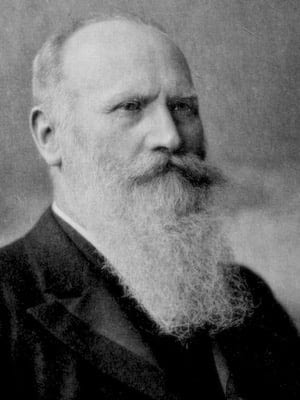Wilhelm von Waldeyer-Hartz
Heinrich Wilhelm Gottfried Waldeyer-Hartz (1836 – 1921) was a German anatomist.
Recognised as one of the forefathers of Anatomical science, Waldeyer’s fascia and Waldeyer’s ring are 2 of his more well known eponyms. Waldeyer introduced the term ‘chromosome‘ and ‘neuron‘ to medical terminology.
Controversially he published incorrect and outlandish views on the anatomical differences of African and Female Neuroanatomy.
Biography
- Born on October 6, 1836 in Hehlen
- 1862 – Medical school initially in Gottingen, Greifswald, and Berlin.
- Professor of Anatomy age just 31 in Breslau, before moving to Strasbourg as Professor, later taking up a 33.5 year post in Berlin as ‘Full Professor for Anatomy and Director for the Anatomical Institute’.
- Received hereditary peerage of the Prussian house of lords on resignation in honour of his contribution to his field
- Died on January 23, 1921
Medical Eponyms
Waldeyer tonsillar ring (1884)
Lymphoid ring of the nasopharynx. Formed by the lymphatic tissue of the pharynx, the palatine tonsil, and the lingual tonsil, as well as other collections of lymph tissue in the area
Other eponyms
Waldeyer gland
Waldeyer neuron theory (1891)
Waldeyer rectosacral fascia (1899)
Ovarian Fossa of Waldeyer
Key Medical Attributions
Chromosome (1888)
Waldeyer, noted the ability of thread-like structures in the nucleus, stained by the dye fuchsin. He coined the term from “chromo” (colour), and “soma” (body).
I would like to permit myself to suggest that the specific technical term chromosomesis attributed to those things which Boveri titled chromatic elements, on which one of the most important parts of caryogenesis, Flemming’s longitudinal splitting, is performed. They are of such importance that a particularly short name appears desirable. If the term which I suggested can be practicably used, then it will become established; if not, it will vanish into oblivion [1888]
Controversies
Women in Medicine
In a speech to the Scientists’ and Physicians’ Convention in 1888, he spoke of the varying development of different brain lobes in men and women as a factor that made the latter unfit for medical study. He was a lifelong opponent of co-education, and although he gave way to women entering medicine, he refused to let them be educated in the same Hall as men.
..obstetrics, a long-time female domain, only flourished as a science when it came into the hands of men, and that the many women who came to power throughout history would testify against the view that women’s abilities were simply restrained by society…according to ‘recent scientific evidence’ the gyri of the male brain were more pronounced than those of female brains, leading to a larger cortical surface, the ‘substrate of our intellectual abilities’…
Waldeyer 1888 p31-40
Lina Morgenstern, a prominent representative of the German women’s movement, countered with:
Highly esteemed Professor! If I attempt to write a contradiction to individual points of your presentation concerning the medical study of women, this will occur from the following aspects: the significance of a presentation lies in the topic which is discussed, in the position which the lecturer occupies in the scientific and civilized world, and in the audience which is being spoken to. In all three directions, your presentation is of the utmost importance for the female movement and should not be underestimated. Especially at this time, as there is a mighty energetic movement in our fatherland, from various female circles, which is demanding female doctors for female and pediatric illnesses as a sanitary and moral necessity and therefore aiming for medical study of women in Germany, the lecture from a famous anatomist (…) seems to be like a declaration of war from the enemy camp: even more so, than the doctors who naturally listened to this speech with great approbation, who are the natural opponents of female study
Morgenstern L. Verlag der Deutschen Hausfrauen-Zeitung 1888
Colonial Anatomy
Examined human specimens of African origin at the height of German colonialism between 1884 and 1914. He failed to progress beyond the racial stereotypes of his time and described ‘‘Negergehirne’’ (‘‘Negro brains’’), as a useful scientific category in brain research.
Described a ‘‘niederer stehende Bildung’’ (‘‘inferior formation’’) in African brains as compared to European brains, and even alluded to similar structures in monkeys in this context [1894;2:1213–1221]
Naming Convention
Known variably as Wilhelm Waldeyer; Wilhelm von Waldeyer-Hartz; Heinrich Wilhelm Gottfried Waldeyer-Hartz.
Major Publications
- Waldeyer W. Wie soll man Anatomie lehren und lernen [How to teach and learn anatomy]. Deutsche medizinische Wochenschrift 1884; 10 (38): 611-614
- Waldeyer W. Atlas der menschlichen und tierischen Haare sowie der ähnlichen Fasergebilde. 1884 Schauenburg
- Waldeyer W. Ueber den lymphatischen Apparat des Pharynx. Deutsche medizinische Wochenschrift, Berlin, 1884, 10 (20): 315 [Waldeyer tonsillar ring]
- Waldeyer W. Beiträge zur normalen und vergleichenden Anatomie des Pharynx mit besonderer Beziehung auf dem Schlingweg. Sitzungsberichte der Königlich Preussischen Akademie der Wissenschaften zu Berlin. 1886;12: 233-250. [Waldeyer tonsillar ring]
- Waldeyer W. Über Karyokinese und ihre Beziehungen zu den Befruchtungsvorgängen. Archiv für mikroskopische Anatomie 1888;32:1-122 [Term: Chromosome]
- Waldeyer W. Das Studium der Medicin und die Frauen. Tageblatt der 61. Versammlung Deutscher Naturforscher und Ärzte 1888; 61: 31–44
- Waldeyer W. Ueber einige neuere Forschungen im Gebiete der Anatomie des Zentralnervensystems. Deutsche medizinische Wochenschrift 1891; 17 (44) :1213-1218 [Term: neuron]
- Waldeyer W. Ueber einige anthropologisch bemerkenswerthe Befunde an Negergehirnen. Sitzungsberichte der Preussischen Akademie der Wissenschaften zu Berlin. 1894;2:1213–1221
- Waldeyer W. Das becken. Topographisch-anatomisch mit besonderer berücksichtigung der chirurgie und gynäkologie. 1899 Bonn: Cohen [Waldeyer Fascia]
- Waldeyer W. Topographie des Gehirns. 1901 Thieme
- Waldeyer W. Lebenserinnerungen. 1920 Bonn: Cohen
References
Biography
- Morgenstern L. Ein offenes Wort über das Studium der Frauen an Herrn Prof. Dr. W. Waldeyer von Lina Morgenstern. Berlin: Verlag der Deutschen Hausfrauen-Zeitung 1888
- Sobotta J. Zum Andenken an Wilhelm von Waldeyer-Hartz. Anat Anz 1922; 56: 1-53
- Winkelmann A. Wilhelm von Waldeyer-Hartz (1836-1921): An anatomist who left his mark: Wilhelm Waldeyer. Clin Anat. 2007 Apr;20(3):231-4
- Scheuerlein H, Henschke F, Köckerling F. Wilhelm von Waldeyer-Hartz—A Great Forefather: His Contributions to Anatomy with Particular Attention to “His” Fascia. Front Surg. 2017 Dec 4;4:74.
- Baskett TF. Waldeyer, Heinrich Wilhelm Gottfried (1836–1921) In: Eponyms and Names in Obstetrics and Gynaecology. 3e. 2019: 440
- Bibliography. Waldeyer-Hartz, Wilhelm von 1836-1921. WorldCat Identities
Eponymous terms and controversies
- Crapp AR, Cuthbertson AM. William Waldeyer and the rectosacral fascia. Surg Gynecol Obstet. 1974 Feb;138(2):252-6
- Cremer T, Cremer C. Centennial of Wilhelm Waldeyer’s introduction of the term “chromosome” in 1888. Cytogenet Cell Genet. 1988;48(2):65-7.
- Fodstad H. The neuron theory. Stereotact Funct Neurosurg 2001;77(1-4):20-4
- Lazar JW. Acceptance of the neuron theory by clinical neurologists of the late-nineteenth century. J Hist Neurosci. 2010 Oct;19(4):349-64
- Moulin T, Clarac F, Petit H, Broussolle E. Neurology outside Paris following Charcot. Front Neurol Neurosci. 2011;29:170-86.
I graduated from Cardiff University in 2017 (MBBCh). I am currently working in Emergency Medicine at SCGH, Perth, Western Australia. In the future I hope to pursue a career in general practice with a special interest in women’s health.
Welsh junior doctor graduated from Cardiff Medical School with MBBCh and BSc in Medical Education. Currently working in emergency medicine in Perth, Australia. Aim to commence GP training in the UK in 2022.



